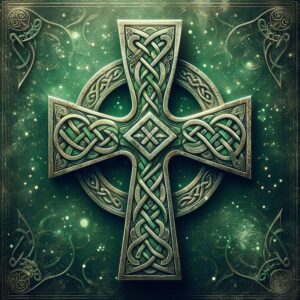
Celtic crosses, Celtic love knot jewelry, Celtic dancing, Celtic music . . . it’s an industry. Since my own choir, the Cherry Creek Chorale, does a Celtic-themed concert every other year, I wanted to find out more about the history of this term. Turns out that, as is usual when you try to reconstruct the past, especially the ancient past, it ain’t all that easy to nail things down. We’re used to thinking in terms of clear-cut events and eras when we look at history, but those divisions are often more for the sake of convenience than reflections of actual reality.
And sometimes terms get thrown around and used in very different contexts. For a good example of this type of thing, let me go on a little bit of a rabbit trail and take a look at another kind-of-ethnic term with several meanings: Goth. There are at least four applications of this term, and they’re all different. First of all, the Goths were a nomadic people who had a hand in helping overthrow the Roman Empire, with the sack of Rome in 410 AD by the Visigoths (western Goths) marking a big step in that process. Next there was something called Gothic architecture, which became popular in the 12th – 16th centuries, many examples of which still survive today, especially in some of Europe’s greatest cathedrals. Did the warlike Goths have anything to do with originating Gothic architecture? No. The only reason that term was used was that this new style, with its pointed arches and flying buttresses, was considered “barbaric” in comparison to the classical architecture of Rome. And who had had a hand in destroying Rome? The Goths, of course, so their name was transferred to the architecture. Gothic architecture became very popular, with a great revival of the style in the 18th and 19th centuries. Along about that time, and continuing on until today, there was the rise of something called “Gothic literature.” Plots of Gothic novels and stories often revolved around a mysterious old house with carvings and crevices and towers and secret staircases. Death, horror, romance—all had their part. So the architecture and the literature went hand in hand in terms of style. (The Addams family’s mansion is, of course, built in the Gothic style.) Nowadays there’s a sort of fashion/lifestyle/music/punk/etc. group called Goths. Lots of black eyeliner and black clothes. While the original Goths tended to go around piercing people with their swords, modern Goths just have . . . piercings. (I am indebted to the website “Frivolous Endeavor” for this analysis and for a great deal of the following material.)
Very much the same variety of uses has happened with the words “Celt” or “Celtic” but without even starting with a known specific people group. The first time we know of that this term was used was way back in ancient Greek times, when the term “keltoi” was used for people living in northern Italy, southern France, and part of Germany. (Of course, folks, none of those countries existed at the time.) What does that term mean? Well, it may refer to a stone hammer. Then again, it may not. And who exactly those people were, and whether or not they had any common identity—well, it’s a mystery. Anyone who wasn’t Greek or Roman could be considered a Celt. What we do know is that the languages of these people, along with those living in Spain, and the British Isles, and even parts of Turkey, had similarities and therefore seemed to have a common origin. All of the so-called Celtic languages on the continent of Europe have disappeared, but in Britain there are still remnants of them: Irish, Scottish Gaelic, Manx, Breton, Cornish, and Welsh.
Ho-kay. Where does that leave us? With a lot of speculation, that’s where. There must have been some “original” settlers in Britain, but who knows who they were? Then the Celts arrived with their new languages, but they were much more interested in fighting each other than in uniting with each other in any way. There’s no one “Celtic culture” that we can point to. Then various later invasions arrived, including the Romans, the Vikings and the Normans, and everything got all mixed up. What’s left for us today are the shadowy remnants of those ancient people, along with much later traditions and, be it said, some modern romanticized notions. Our current Celtic conceptions probably wouldn’t make too much sense to someone living in 500 B.C. (“Ah, so we invented that knot, did we? Very nice.”)
But just because we can’t be sure who these people were, when they arrived or from where, that doesn’t mean that there isn’t a rich artistic tradition associated with folk memories of them. I have this picture in my head of the British Isles, with a big spreading splotch in the middle that represents the victorious invaders and other areas around the edges that show the earlier arrivals being pushed to the margins. There’s no hard and fast line anywhere; the borders have a lot of overlap. Some groups hold on tenaciously to their identity, or what they’ve been told is their identity. Others just join in with the victors. And there are real consequences to these differences, as we saw as recently as 2014 when there was a serious question as to whether Scotland would remain as part of Great Britain or become an independent nation. They voted to stay, but there were 1.6 million who voted to go against the 2 million majority. That’s a pretty substantial independence party! (I’m sure that some of them were wearing kilts. Oh, and does the word “keltoi” mentioned above have anything to do with kilts? Probably not. Sigh.)
But don’t let any of the foregoing sully your enjoyment of Celtic music!
© Debi Simons

